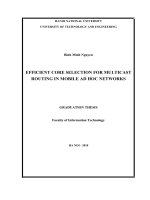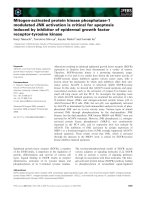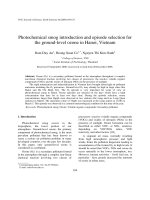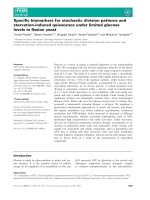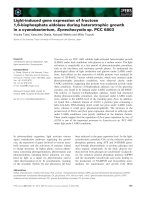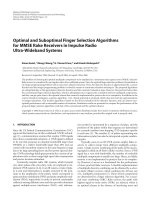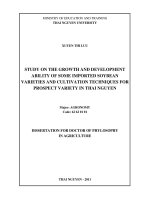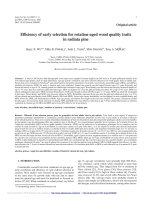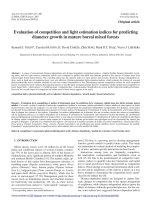Fishery induced selection for slow somatic growth in european eel
Bạn đang xem bản rút gọn của tài liệu. Xem và tải ngay bản đầy đủ của tài liệu tại đây (264.79 KB, 7 trang )
5/2/2018
FisheryInduced Selection for Slow Somatic Growth in European Eel
Fishery-Induced Selection for Slow Somatic Growth in
European Eel
Daniele Bevacqua, Fabrizio Capoccioni
Published: May 22, 2012
, Paco Melià, Simone Vincenzi, José M. Pujolar, Giulio A. De Leo, Eleonora Ciccotti
/>
Abstract
Both theoretical and experimental studies have shown that fishing mortality can induce adaptive responses in body growth rates of
fishes in the opposite direction of natural selection. We compared body growth rates in European eel (Anguilla anguilla) from three
Mediterranean stocks subject to different fishing pressure. Results are consistent with the hypotheses that i) fastgrowing
individuals are more likely to survive until sexual maturity than slowgrowing ones under natural conditions (no fishing) and ii)
fishing can select for slowgrowing individuals by removing fastgrowing ones. Although the possibility of humaninduced evolution
seems remote for a panmictic species like such as the European eel, further research is desirable to assess the implications of the
intensive exploitation on this critically endangered fish.
Citation: Bevacqua D, Capoccioni F, Melià P, Vincenzi S, Pujolar JM, De Leo GA, et al. (2012) FisheryInduced Selection for
Slow Somatic Growth in European Eel. PLoS ONE 7(5): e37622. />Editor: Howard Browman, Institute of Marine Research, Norway
Received: January 27, 2012; Accepted: April 22, 2012; Published: May 22, 2012
Copyright: © 2012 Bevacqua et al. This is an openaccess article distributed under the terms of the Creative Commons
Attribution License, which permits unrestricted use, distribution, and reproduction in any medium, provided the original author
and source are credited.
Funding: This work was supported by the Italian Ministry of Research (PRIN project 153 #2006054928). The funders had no
role in study design, data collection and analysis, decision to publish, or preparation of the manuscript.
Competing interests: The authors have declared that no competing interests exist.
Introduction
Fast body growth is traditionally interpreted as a beneficial trait in fish, according to the belief that “faster is better” (e.g. [1]). In
general, natural mortality rates are negatively linked to body size via allometric relationships (e.g. [2], [3]), and rapid body growth
shortens the duration of the permanence of fish in the most vulnerable size classes before reproduction. However, the “faster is
better” hypothesis has been challenged by recent studies showing that body growth itself has a physiological tradeoff with other
vital rates [4].
Fishing mortality can largely exceed natural mortality and has a strong sizeselective effect, as most fisheries preferentially target
larger and/or faster growing individuals [5]. Fishing can induce adaptive responses, intended to increase fitness, in body growth
rates, resulting from changes in gene frequency across generations (adaptive evolution) or from changes in phenotypic distribution
over time, without genetic change (adaptive plasticity). In particular, a decline in average body growth rate has been predicted as a
likely response to selective removal of fastgrowing individuals by fisheries [5].
In the last decades, the dramatic decline of the global European eel (Anguilla anguilla) stock has raised worldwide concern.
Phenotypic plasticity in body growth rate is extremely high in European eel [6], [7]. However, no study so far has explored the
possible existence of different selective pressures on body growth in different environments. In the present study, we compare body
growth rates in eels from three Mediterranean stocks subject to different exploitation levels to test i) if fastgrowing individuals have
higher survival during the prereproductive growing phase in natural conditions and ii) if fishing pressure can select for slower body
growth of spawners.
Materials and Methods
The European eel is a semelparous, catadromous and panmictic species exploited across its entire distribution area at different life
stages [8]. After spawning in the Sargasso Sea, eel larvae are carried by oceanic currents towards the continental shelf of Europe
and North Africa, metamorphose into glass eels and settle in continental waters, where they feed and grow during the socalled pre
reproductive yellow phase. Eels are sexually undifferentiated at the beginning of the yellow phase and germ cells start
differentiating in individuals >20 cm [9]. When eels reach the maturation size (ca. 45 cm for males and 60 cm for females), they
/>
1/7
5/2/2018
FisheryInduced Selection for Slow Somatic Growth in European Eel
undergo a metamorphosis to the silver stage, stop eating and growing and start their migration back to the Sargasso Sea, where
they mate, spawn and eventually die [10]. As maturation rate is size rather than agedependent [11] and body growth is affected by
high interindividual variability, silver eels escaping each year from continental waters are not homogeneous with respect to age.
Between 2007 and 2009, we sampled yellow and silver eels at three distinct Mediterranean sites (Fig. 1) characterized by different
levels of fishing pressure: i) the low course of the Tiber river (TIB), ii) the Fogliano lake (FOG), and iii) the Lesina lagoon (LES). In
TIB, the fishery mainly targets small yellow eels (<40 cm) that are then sent to aquaculture facilities [12]. In FOG, eel exploitation is
prohibited. In LES, fyke nets (which have a larger mesh size than those used in TIB) intercept silver eels >40 cm [13]. Eels were
collected by means of both commercial and experimental fyke nets. This allowed us to obtain also individuals smaller than those
commonly caught by commercial fisheries. We sacrificed, measured for total length (L) and aged through otolith reading a total of
1210 eels (NTIB = 471; NFOG = 273; NLES = 466). We determined sex and maturation stage by histological examination of gonads [14]
and computed Pankhurst ocular index (OI; cf. [15]). To test for possible selection for fast/slow body growth during the early yellow
phase, we compared the mean body growth rate between age 1 and 3 of subadult and silver eels. The “subadult” group included
individuals with L≤35 cm, OI≤6.5 and gonads with undifferentiated germ cells. The “silver” group included individuals with OI>6.5
and fully differentiated testis or ovaries. All the silver individuals were above the cutoff length of 35 cm. As the potential for body
growth (i.e. being a slow or a fast grower) is maintained through the whole yellow phase [6], we assumed that the growth rate
distribution of subadults reflects the original variability of this vital trait within a stock (before selection), while the growth rate
distribution of silver eels reflects the residual variation (after selection), namely the one that better fits under the set of selective
(natural and/or anthropogenic) forces playing at a specific site.
Figure 1. Study sites.
Location of the three study sites (lower Tiber river, Fogliano lake and Lesina lagoon).
/>To test these hypotheses, we backcalculated body length Li at age i for individuals belonging to the “subadult” and “silver” groups
according to the “biological intercept” method [16]:
(1)
where Lc is body length at capture, Ri, Rc and R0 are the otolith radii at annulus i, at capture time and at the beginning of the
continental phase (which corresponds to an initial body length L0 = 7 cm).
Finally, we computed body growth rate g between age 1 and 3 for each individual as:
(2)
(see Online Supporting Information, Text S1 for details).
For each stock (TIB/FOG/LES) and group (subadult/silver), we assessed the uncertainty in the estimate of mean growth rates via
bootstrapping, with data resampled 10,000 times, and computed confidence intervals with the percentile method. As for silver
individuals, we analyzed males and females separately to account for possible differences in body growth caused by sexual
dimorphism, because silver males are systematically smaller than silver females. For each of the three stocks, we tested for
differences in body growth rate between subadult and silver individuals through the following randomization test:
1. we calculated the absolute difference between the mean growth rate of subadults, gsa, and that of silver individuals, gs:
(3)
where subscript “obs” indicates that the value has been computed on observed data. The null hypothesis is that
does not significantly differ from
what would be expected by chance (i.e. if there were no difference between the early growth rate experienced by subadult and silver individuals) and the
alternative hypothesis is that it does;
1. we randomly reassigned the “subadult” and “silver” label to each individual and calculated the sample statistic
for this randomized dataset. The
subscript “rand” indicates that, in this case, the value has been calculated from the randomized data. We replicated this reshuffling procedure 10,000
times, obtained a vector of
(n = 1, 2, …10,000), and derived an empirical null distribution for
;
/>
2/7
5/2/2018
FisheryInduced Selection for Slow Somatic Growth in European Eel
2. from this empirical distribution, we computed the pvalue for the null hypothesis (i.e. the probability that the observed difference in growth rates between
groups is due to chance) as the proportion of
that are greater than or equal to
.
To increase the accuracy of the randomization test, we carried out statistical analyses only on groups including at least 10
individuals. Since subadult and silver individuals belong to different cohorts, we run a oneway ANOVA (see OSI; Table S1 and
Figure S1) to test for possible intercohort variation of body growth caused by environmental factors not explicitly accounted for in
the analysis. Finally, we tested through a regression analysis (see OSI; Table S2 and Figure S2) whether growth rate affects
maturation size.
Results
The subadult group included 103, 33 and 22 sexually undifferentiated individuals in TIB, FOG and LES, respectively. Silver males
were 86, 48 and 5, while silver females were 8, 47 and 42 in TIB, FOG and LES, respectively. Only 33% of the 1210 sacrificed eels
could be classified as subadults or silver, as most individuals were sexually differentiated but still in the yellow stage.
Individual body growth rates between age 1 and 3 (eq. 2) varied between 1.8–17.5 (TIB), 3.5–12.7 (FOG), and 3.9–19.5 (LES) cm
yr−1. The bootstrapped distribution of mean growth rate (population mean) are reported in Fig. 2 for the three stocks. Average
growth rate of subadults from TIB, FOG and LES was equal to 7.5 (90% CI 7.2–7.7), 6.4 (5.9–7.0) and 7.9 (7.2–8.7) cm yr−1,
respectively, while for silver individuals it was 6.3 (5.8–6.8) cm yr−1 for silver males in TIB, 8.8 (8.3–9.3) and 8.4 (7.8–8.9) cm yr−1
for silver males and females in FOG, respectively, and 9.8 (8.8–10.8) cm yr−1 for silver females in LES.
Figure 2. Growth rate distribution of subadults, silver males and silver females.
Empirical bootstrap distribution of body growth rate (population mean) between age 1 and 3 of subadult European eels
(shaded areas), silver males (solid lines) and silver females (dotted lines) sampled at three Mediterranean sites: a Tiber river,
b Fogliano lake and c Lesina lagoon.
/>The randomization test showed that mean growth rate in TIB was significantly lower in silver (male) eels than in subadults
(P<0.01). In contrast, in FOG the growth rates of both male and female silver eels were significantly higher than that of subadults
(P<0.01), while in LES (where only silver eels are fished) the difference between silver (female) eels and the subadult sample were
barely above statistical significance (P = 0.06). Body growth rate did not vary among cohorts in TIB (P = 0.20) and FOG (P = 0.35),
while it varied in LES (P<0.01; see OSI for details). There was no significant between eel body growth rate and body size at
silvering, irrespective of sex and site (see OSI).
Discussion
Results confirm the high plasticity of eel body growth, with fastgrowing individuals that can grow up to 10 times more rapidly than
slowgrowing ones (e.g. 17.5 vs. 1.8 cm yr−1 in TIB). At FOG, where the local eel stock is unexploited, fastgrowing eels have a
higher probability to survive the prereproductive stage. In most fish species, this is generally due to the fact that fastgrowing
/>
3/7
5/2/2018
FisheryInduced Selection for Slow Somatic Growth in European Eel
individuals attain larger sizes more rapidly and are therefore less susceptible to predation [1]. In our case, predation is likely to play
a minor role as a driver of selection, because eels are generally top predators (but see [17]). Instead, the pattern we observed may
be better explained in terms of higher competitive ability of fast growers. Superiority in interference competition is known to be
largely determined by body size [18]. In eel species, fast growth is known to be favorable in aquaculture conditions, where fast
growing individuals can reduce feeding rates of slowgrowing ones and often show cannibalistic behavior [10]. Our results suggest
that the “faster is better” hypothesis may hold for A. anguilla also in the wild, provided that fishing pressure is absent.
On the other hand, when yellow eels are subject to high fishing pressure, as in the case of TIB, the silver group is composed by
slowergrowing individuals. Higher vulnerability to fishing of fastgrowing eels might be related to their behavior. In a wholelake
manipulative experiment conducted by Biro & Post [19] on rainbow trout Oncorhynchus mykiss, fastgrowing individuals showed
more aggressive feeding behavior, which increased their capture rates. An analogous mechanism (more aggressive behavior
leading to fast growth and higher catchability) might explain the patterns observed in our study. Different growth rates in eels can
reflect feeding preferences: fastgrowing individuals are mostly piscivorous and must actively chase their prey, while slowgrowing
ones usually feed on benthic organisms, whose capture requires a less active behavior [10]. Therefore, also in the case of eels, a
trait providing a competitive advantage in unexploited conditions may become a shortcoming under heavy fishing pressure, as
envisioned by Biro & Post [19].
Results from LES suggest that a fishery targeting silver eels does not override natural selection towards fast growers. This result is
not surprising, as harvested silver eels have already concluded their growing phase. In this respect, the LES study site is more
similar to the unexploited FOG site, in terms of selective pressure exerted on growth rate.
Interannual environmental variation (e.g. food availability and distribution, temperature, salinity) may be responsible for observed
changes in growth rates [20]. However, growth rates computed for different cohorts of yellow eels in TIB and FOG showed no
significant intercohort differences, a result that partially rules out the possibility that environmental factors may have caused short
term changes in body growth. Of course, it remains the possibility that older cohorts of silver eels might have experienced
substantially different conditions in their early life phase with respect to the more recently recruited subadults. If this were the case,
differences in growth rate distributions would not be due only to fishing pressure, but also to other environmental factors we could
not control for. Unfortunately, there are no samples dating back to the early period of permanence in inland waters of the oldest
silver eels. As a consequence, there is no way to formally test whether older eels experienced different environmental conditions in
their early years of life with respect to what experienced by younger cohorts of yellow eels in the late years of the last decade.
However, there is no evidence that environmental conditions have dramatically changed in any of the three sites during the last
twenty years [21]–[24]. The only exception is for water salinity in LES, which underwent wide fluctuations in the last decade
(between 15 and 25 [25], [26]). The significant intercohort variation observed in the growth rate of subadults from LES might
reflect the influence of water salinity on body growth [27]. In this specific case, our analysis could have been biased by the changed
conditions and we cannot reach a definitive conclusion with respect to this site.
A better insight into the selective force of yellow eel fishery on growth rate will be achieved only by future longterm experiments
gathering information not just on eel growth, age and size at maturity, but also on historical series of environmental variables. A text
book reference case with respect to this issue is the study conducted by Swain et al. [28], who included proxies for interannual
changes of the biotic and abiotic environment (i.e. stock density and temperature) and estimated their effect on growth rates,
together with the effect of fishery selection on a 30year historical series.
In conclusion, despite the abovementioned limitations of our study, results are consistent with the hypothesis that intensive fishing
during the growing phase preferentially removes fastgrowing eels. Studies on other exploited fish stocks reported that evolutionary
changes in response to selective exploitation can result in reduced population productivity even when the stock is released from
fishing pressure, hence reducing the capacity for population recovery [29]. In eel stocks released from fishing pressure, fishery
induced selection towards slower growth would determine less productivity of spawners, as individuals would be more susceptible
to competition, while per capita fertility would not be affected, because maturation size is not linked to growth rate (as suggested by
our results: see OSI). The possibility of a fisheryinduced evolution of body growth seems remote for a panmictic species such as
the European eel, at least as long as a sufficient amount of spawners come from unexploited stocks. However, considering the
critical state of this species, the open debate on the processes leading to its current decline, and according to the precautionary
principle [30] our findings urge further research to investigate the impacts that the widespread and systematic selection for smaller,
slowgrowing eels might have on the reproductive output of the spawning stock.
Supporting Information
Table S1.
Results of oneway ANOVA of body growth rate with respect to cohort for the three study sites (TIB: Tiber river; FOG: Fogliano lake;
LES: Lesina lagoon).
/>(DOC)
Table S2.
Regression analysis of body length of silver eels vs. body growth rate for the three study sites (TIB: Tiber river; FOG: Fogliano lake;
LES: Lesina lagoon).
/>(DOC)
Figure S1.
/>
4/7
5/2/2018
FisheryInduced Selection for Slow Somatic Growth in European Eel
Boxwhisker plots of individual body growth rate for different cohorts at a) Tiber river, b) Fogliano lake and c) Lesina lagoon. Lines
within the boxes represent lower quartile, median and upper quartile values. Vertical dashed lines extend from quartile values to the
most extreme data value within 1.5 times interquartile range. Outliers are plotted individually.
/>(DOC)
Figure S2.
Total length (cm) of silver eels against body growth rate (cm/yr) and relevant regression lines for a) Tiber river, b) Fogliano lake and
c) Lesina lagoons. Triangles and circles indicate males and females, respectively.
/>(DOC)
Text S1.
/>(DOC)
Author Contributions
Conceived and designed the experiments: DB FC. Performed the experiments: FB EC. Analyzed the data: FC DB. Contributed
reagents/materials/analysis tools: FC EC. Wrote the paper: DB PM. Contribution to analysis and interpretation of data: PM SV JMP
GDL EC. Critical review of the manuscript: PM SV JMP GDL EC. Drafting the article and revising it critically for important intellectual
content: GDL EC.
References
1. Schluter D (1995) Adaptive radiation in sticklebacks: tradeoffs in feeding performance and growth. Ecology 76: 82–90.D. Schluter1995Adaptive radiation
in sticklebacks: tradeoffs in feeding performance and growth.Ecology768290
View Article
PubMed/NCBI
Google Scholar
2. Lorenzen K (1996) The relationship between body weight and natural mortality in juvenile and adult fish: a comparison of natural ecosystems and
aquaculture. J Fish Biol 49: 627–642.K. Lorenzen1996The relationship between body weight and natural mortality in juvenile and adult fish: a comparison
of natural ecosystems and aquaculture.J Fish Biol49627642
View Article
PubMed/NCBI
Google Scholar
3. Bevacqua D, Melià P, De Leo GA, Gatto M (2011) Intraspecific scaling of natural mortality in fish: the paradigmatic case of the European eel. Oecologia
165: 333–339.D. BevacquaP. MeliàGA De LeoM. Gatto2011Intraspecific scaling of natural mortality in fish: the paradigmatic case of the European
eel.Oecologia165333339
View Article
PubMed/NCBI
Google Scholar
4. Arendt JD (1997) Adaptive intrinsic growth rates: an integration across taxa. Q Rev Biol 72: 149–177.JD Arendt1997Adaptive intrinsic growth rates: an
integration across taxa.Q Rev Biol72149177
View Article
PubMed/NCBI
Google Scholar
5. Law R (2000) Fishing, selection, and phenotypic evolution. ICES J Mar Sci 57: 659–668.R. Law2000Fishing, selection, and phenotypic evolution.ICES J
Mar Sci57659668
View Article
PubMed/NCBI
Google Scholar
6. Poole WR, Reynolds JD (1998) Variability in growth rate in European eel Anguilla anguilla (L.) in a western Irish catchment. Biol Environ 98: 141–145.WR
PooleJD Reynolds1998Variability in growth rate in European eel Anguilla anguilla (L.) in a western Irish catchment.Biol Environ98141145
View Article
PubMed/NCBI
Google Scholar
7. Melià , P , Bevacqua D, Crivelli AJ, Panfili J, De Leo GA, et al. (2006) Sex differentiation of the European eel in brackish and freshwater environments: a
comparative analysis. J Fish Biol 69: 1228–1235.MeliàPD. BevacquaAJ CrivelliJ. PanfiliGA De Leo2006Sex differentiation of the European eel in
brackish and freshwater environments: a comparative analysis.J Fish Biol6912281235
View Article
PubMed/NCBI
Google Scholar
8. Dekker W (2003) On the distribution of the European eel (Anguilla anguilla) and its fisheries. Can J Fish Aquat Sci 60: 787–799.W. Dekker2003On the
distribution of the European eel (Anguilla anguilla) and its fisheries.Can J Fish Aquat Sci60787799
View Article
PubMed/NCBI
Google Scholar
9. Melià , P , Bevacqua D, Crivelli AJ, De Leo GA, Panfili J, et al. (2006) Age and growth of Anguilla anguilla in the Camargue lagoons. J Fish Biol 68: 876–
890.MeliàPD. BevacquaAJ CrivelliGA De LeoJ. Panfili2006Age and growth of Anguilla anguilla in the Camargue lagoons.J Fish Biol68876890
View Article
PubMed/NCBI
Google Scholar
10. Tesch FW (2003) The eel, 5th edn. Oxford: Blackwell Science. 408 p.FW Tesch2003The eel, 5th edn.OxfordBlackwell Science408
/>
5/7
5/2/2018
FisheryInduced Selection for Slow Somatic Growth in European Eel
11. Bevacqua D, Melià P, Crivelli AJ, De Leo GA, Gatto M (2006) Timing and rate of sexual maturation of European eel in brackish and freshwater
environments. J Fish Biol 69: 200–208.D. BevacquaP. MeliàAJ CrivelliGA De LeoM. Gatto2006Timing and rate of sexual maturation of European eel in
brackish and freshwater environments.J Fish Biol69200208
View Article
PubMed/NCBI
Google Scholar
12. Ciccotti E (2011) Report on the eel stock and fishery in Italy 2010/11. In: ICES (2011) International Council for the Exploration of the Sea. Report of the
ICES/EIFAC Working Group on Eels. EIFAAC Occasional Paper. No. 48. ICES CM: E. Ciccotti2011Report on the eel stock and fishery in Italy 2010/11.
In: ICES (2011) International Council for the Exploration of the Sea. Report of the ICES/EIFAC Working Group on Eels. EIFAAC Occasional Paper. No.
48.ICESCM
View Article
PubMed/NCBI
Google Scholar
13. Rossi R, Villani P (1980) A biological analysis of eel catches, Anguilla anguilla L., from the lagoons of Lesina and Varano, Italy. J Fish Biol 16: 413–
423.R. RossiP. Villani1980A biological analysis of eel catches, Anguilla anguilla L., from the lagoons of Lesina and Varano, Italy.J Fish Biol16413423
View Article
PubMed/NCBI
Google Scholar
14. Colombo G, Grandi , G (1996) Histological study of the development and sex differentiation of the gonad in the European eel. J Fish Biol 48: 493–512.G.
ColomboGrandiG1996Histological study of the development and sex differentiation of the gonad in the European eel.J Fish Biol48493512
View Article
PubMed/NCBI
Google Scholar
15. Pankhurst NW (1982) Relation of visual changes to the onset of sexual maturation in the European eel Anguilla anguilla (L.). J Fish Biol 21: 127–140.NW
Pankhurst1982Relation of visual changes to the onset of sexual maturation in the European eel Anguilla anguilla (L.).J Fish Biol21127140
View Article
PubMed/NCBI
Google Scholar
16. Campana SE (1990) How reliable are growth backcalculations based on otoliths? Can J Fish Aquat Sci 47: 2219–2227.SE Campana1990How reliable
are growth backcalculations based on otoliths?Can J Fish Aquat Sci4722192227
View Article
PubMed/NCBI
Google Scholar
17. Bevacqua D, Andrello M, Melià P, Vincenzi S, De Leo GA, et al. (2011) Densitydependent and interspecific interactions affecting European eel
settlement in freshwater habitats. Hydrobiologia 671: 259–265.D. BevacquaM. AndrelloP. MeliàS. VincenziGA De Leo2011Densitydependent and inter
specific interactions affecting European eel settlement in freshwater habitats.Hydrobiologia671259265
View Article
PubMed/NCBI
Google Scholar
18. Sogard SM (1997) Sizeselective mortality in the juvenile stage of teleost fishes: a review. B Mar Sci 60: 1129–1157.SM Sogard1997Sizeselective
mortality in the juvenile stage of teleost fishes: a review.B Mar Sci6011291157
View Article
PubMed/NCBI
Google Scholar
19. Biro P, Post JR (2008) Rapid depletion of genotypes with fast growth and bold personality traits from harvested fish populations. Proc Natl Acad Sci U S
A 105: 2919–2922.P. BiroJR Post2008Rapid depletion of genotypes with fast growth and bold personality traits from harvested fish populations.Proc Natl
Acad Sci U S A10529192922
View Article
PubMed/NCBI
Google Scholar
20. Enberg K, Jørgensen C, Dunlop ES, Varpe Ø, Boukal DS, et al. (2012) Fishinginduced evolution of growth: concepts, mechanisms and the empirical
evidence. Mar Ecol 33: 1–25.K. EnbergC. JørgensenES DunlopØ. VarpeDS Boukal2012Fishinginduced evolution of growth: concepts, mechanisms and
the empirical evidence.Mar Ecol33125
View Article
PubMed/NCBI
Google Scholar
21. Pettine M, La Note T, Macchi G, Mihero FJ (1982) Heavy metals in the Tiber river basin. Mar Pollut Bull 13: 327–329.M. PettineT. La NoteG. MacchiFJ
Mihero1982Heavy metals in the Tiber river basin.Mar Pollut Bull13327329
View Article
PubMed/NCBI
Google Scholar
22. Regione Lazio Centro Funzionale Regionale (2011) Ufficio Idrografico e Mareografico Area D2/2S/09. Daily mean data of water quality of Porta Portese
station. Regionale Regione Lazio Centro Funzionale2011Ufficio Idrografico e Mareografico Area D2/2S/09.Daily mean data of water quality of Porta
Portese station
23. Gravina M, Ardizzone G, Scaletta F, Chimenz C (1989) Descriptive analysis and classification of benthic communities in some Mediterranean coastal
lagoons (central Italy). Mar Ecol 10: 141–166.M. GravinaG. ArdizzoneF. ScalettaC. Chimenz1989Descriptive analysis and classification of benthic
communities in some Mediterranean coastal lagoons (central Italy).Mar Ecol10141166
View Article
PubMed/NCBI
Google Scholar
24. Signorini A, Massini G, Migliore G, Tosoni M, Varrone C, et al. (2008) Sediment biogeochemical differences in two pristine Mediterranean coastal lagoons
(in Italy) characterized by different phanerogam dominance – A comparative approach. Aquat Conserv: Mar Freshwat Ecosyst 18: 27–44.A. SignoriniG.
MassiniG. MiglioreM. TosoniC. Varrone2008Sediment biogeochemical differences in two pristine Mediterranean coastal lagoons (in Italy) characterized
by different phanerogam dominance – A comparative approach.Aquat Conserv: Mar Freshwat Ecosyst182744
View Article
PubMed/NCBI
Google Scholar
/>
6/7
5/2/2018
FisheryInduced Selection for Slow Somatic Growth in European Eel
25. Nonnis Marzano C, Scalera L, Fianchini A, Gravina F, Mercurio M, et al. (2003) Distribution, persistence and change in the macrobenthos of the lagoon
of Lesina (Apulia, southern Adriatic Sea). Oceanol Acta 26: 57–66.C. Nonnis MarzanoL. ScaleraA. FianchiniF. GravinaM. Mercurio2003Distribution,
persistence and change in the macrobenthos of the lagoon of Lesina (Apulia, southern Adriatic Sea).Oceanol Acta265766
View Article
PubMed/NCBI
Google Scholar
26. Roselli L, Fabbrocini A, Manzo C, D’Adamo R (2009) Hydrological heterogeneity, nutrient dynamics and water quality of a nontidal lentic ecosystem
(Lesina Lagoon, Italy). Estuar Coast Shelf Sci 84: 539–552.L. RoselliA. FabbrociniC. ManzoR. D’Adamo2009Hydrological heterogeneity, nutrient
dynamics and water quality of a nontidal lentic ecosystem (Lesina Lagoon, Italy).Estuar Coast Shelf Sci84539552
View Article
PubMed/NCBI
Google Scholar
27. Cairns DK, Secor DA, Morrison WE, Hallett JA (2009) Salinitylinked growth in anguillid eels and the paradox of temperatezone catadromy. J Fish Biol
74: 2094–2114.DK CairnsDA SecorWE MorrisonJA Hallett2009Salinitylinked growth in anguillid eels and the paradox of temperatezone catadromy.J
Fish Biol7420942114
View Article
PubMed/NCBI
Google Scholar
28. Swain DP, Sinclair AF, Hanson JM (2007) Evolutionary response to sizeselective mortality in an exploited fish population. Proc R Soc Lond B Bio. Sci
274: 1015–22.DP SwainAF SinclairJM Hanson2007Evolutionary response to sizeselective mortality in an exploited fish population. Proc R Soc Lond B
Bio.Sci274101522
View Article
PubMed/NCBI
Google Scholar
29. Walsh M, Munch S, Chiba S, Conover D (2006) Maladaptive changes in multiple traits caused by fishing: impediments to population recovery. Ecol Lett
9: 142–8.M. WalshS. MunchS. ChibaD. Conover2006Maladaptive changes in multiple traits caused by fishing: impediments to population recovery.Ecol
Lett91428
View Article
PubMed/NCBI
Google Scholar
30. ICES (2011) International Council for the Exploration of the Sea. Report of the ICES/EIFAC Working Group on Eels. EIFAAC Occasional Paper. No. 48.
ICES CM: ICES2011International Council for the Exploration of the Sea. Report of the ICES/EIFAC Working Group on Eels. EIFAAC Occasional Paper.
No. 48.ICESCM
View Article
PubMed/NCBI
Google Scholar
/>
7/7
